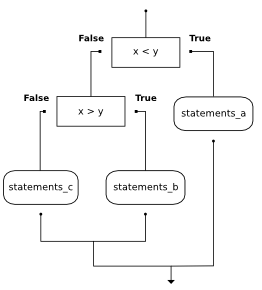7.6. Nested conditionals¶
One conditional can also be nested within another. For example,
assume we have two integer variables, x and y. The following
pattern of selection shows how we might decide how they are related to
each other.
if x < y:
print("x is less than y")
else:
if x > y:
print("x is greater than y")
else:
print("x and y must be equal")
The outer conditional contains two branches. The second branch (the
else from the outer) contains another if statement, which has two
branches of its own. Those two branches could contain conditional
statements as well.
The flow of control for this example can be seen in this flowchart illustration.

Here is a complete program that defines values for x and y.
Run the program and see the result. Then change the values of the
variables to change the flow of control.
Note
In some programming languages, matching the if and the else is a problem. However, in Python this is not the case. The indentation pattern tells us exactly which else belongs to which if.
If you are still a bit unsure, here is the same selection as part of a
codelens example. Step through it to see how the correct print is
chosen.
(sel1)
Check your understanding
- No
- This is a legal nested if-else statement. The inner if-else statement is contained completely within the body of the outer else-block.
- Yes
- This is a legal nested if-else statement. The inner if-else statement is contained completely within the body of the outer else-block.
select-6-1: Will the following code cause an error?
x: int
x = -10
if x < 0:
print("The negative number " + str(x) + " is not valid here.")
else:
if x > 0:
print(str(x) + " is a positive number")
else:
print(str(x) + " is 0")